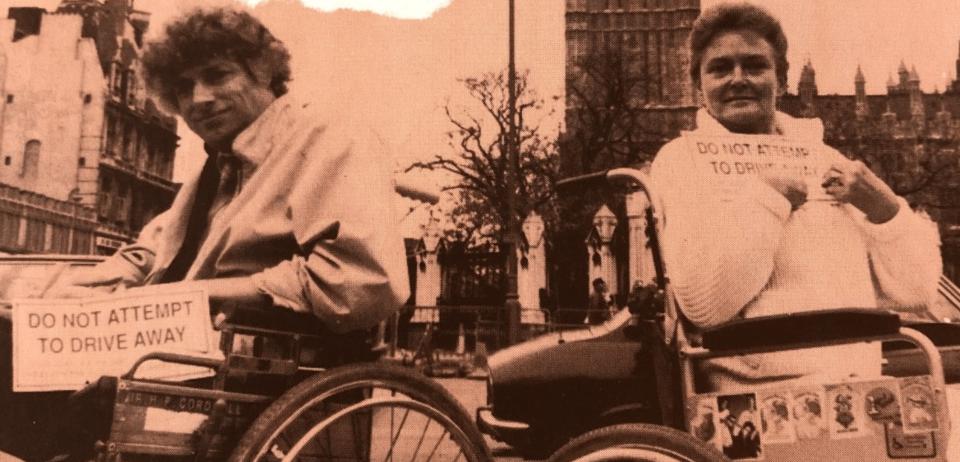Transport for All’s history is steeped in the protest and punk rock movements of the 1980s, with the now-infamous scenes of wheelchair users chaining themselves to buses. Back then all buses had stairs, wheelchair users had to ride the train in the guards van with all the cargo and you could forget getting a taxi. Disabled people decided that they needed an alternative.
1980s: The beginnings
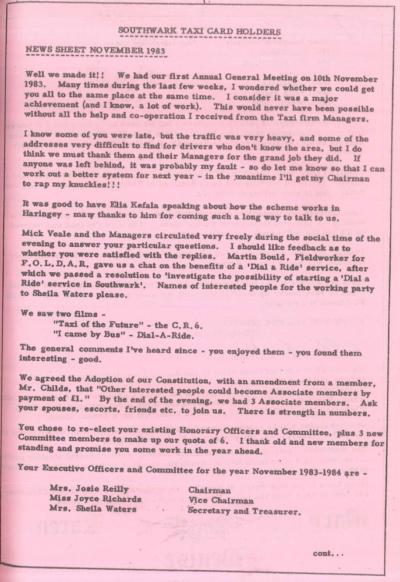
In 1980 the first Dial-a-Ride services were established that were run both by disabled people and for disabled people. These first schemes were proposed by disability groups in different parts of London in the late 1970s and the pioneer scheme was in Islington, which began operating in 1980, followed in 1982 by Brent, Hammersmith and Fulham, Ealing and Camden.
Around the same time, in September 1982, the Greater London Council decided to introduce a ‘programme of practical experiments to help the disabled to travel in London’ to increase the provision of accessible transport. One of these was the Taxicard scheme, which was piloted in the London Borough of Southwark. Due to its incredible success, it was expanded to all of London soon afterwards.
Left: Southwark Disablement Association newsletter (1983)
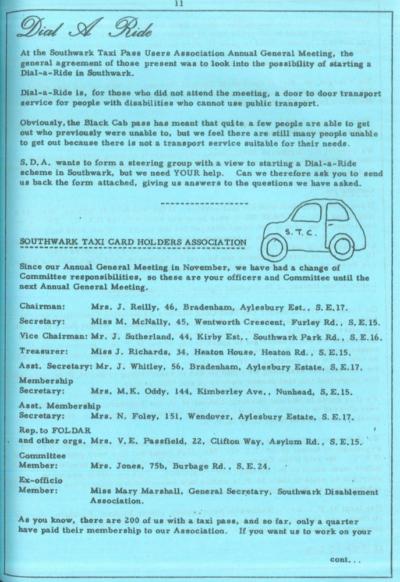
Every London borough that had a Dial-a-Ride also had management committees which were made up of not just the managers who were running the service, but also Disabled people who were using the service. It was incredibly unusual at the time for Disabled people to have a say in the way that services that had been created for them were run, and a research paper about door to door transport in 1988 reflected the benefits of this, writing that “staff attitudes to PWDs [persons with disabilities] are notably better than those traditionally held by the Social Services and other institutionalized transport operatives where users have no say in what is provided.”
This was ground-breaking, and the users of the service wanted to meet and talk, and make sure the service continued working for them. And so in 1983 the Federation of London Dial-a-Rides (FoLDaR) was set up, funded by the Greater London Council, to represent the interests of all of the Dial-a-Ride services across London. Users of Taxicard in different boroughs of London had their own users networks too, the first of which was set up soon after Taxicard was introduced in order to provide information about the scheme, give feedback to the council and also take complaints.
Right: Southwark Disablement Association newsletter (1983)
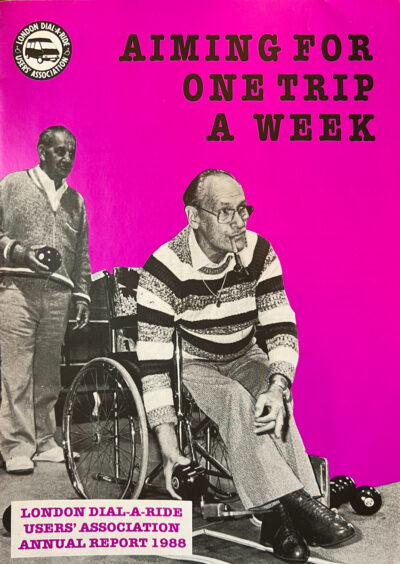
However, in 1986 the Greater London Council was abolished and the responsibility of funding Taxicard and Dial-a-Ride was passed to London Regional Transport (the organisation which later became Transport for London).
Even though they took over the Dial-a-Ride services, they refused to fund the users’ organisation FoLDaR, but they also refused to fund the Taxicard scheme in its entirety. Their solution for continuing the service was for individual London Boroughs to fund Taxicard, and the newly created London Borough Grants Committee (LBGC) instead became the group that funded FoLDaR.
It was widely agreed by both the organisation and their new funders that they should change their direction and focus on representing the users of Dial-a-Ride: giving disabled people a say in the services we used.
So FoLDaR changed not only its scope, but its name as well, to the London Dial-a-Ride Users’ Association, or the catchy sounding LDaRUA for short.
Left: London Dial-a-Ride Users’ Association Annual Report (1988)
We believe that public transport should be available to everyone as a basic human right, but until all passenger transport is made accessible to disabled people, we remain dependent mainly on Dial-a-Ride to enable us to carry out everyday activities.
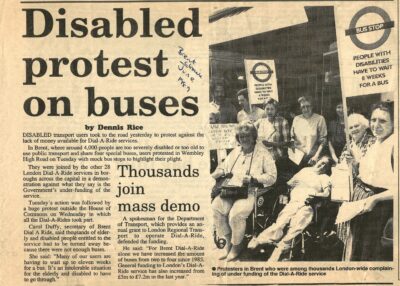
The LDaRUA’s flagship campaign in the late 1980s was fighting for more funding for Dial-a-ride services. At the time, users could only take an average of one trip every eleven weeks. LDaRUA launched their campaign under the banner aiming for ONE TRIP A WEEK.
In July 1989, the organisation ran Dial-a-Ride week, including a mass protest at the entrance of the House of Commons, where disabled people lobbied MPs directly – including Jeremy Corbyn, Dianne Abbott, and Ken Livingstone. The stunt attracted wide media attention.
Right: Newspaper clipping from Brent Chronicle (1989)
One trip every eleven weeks is not a level of service that any other sector of the public is asked to tolerate. Nobody should ask us to put up with it.
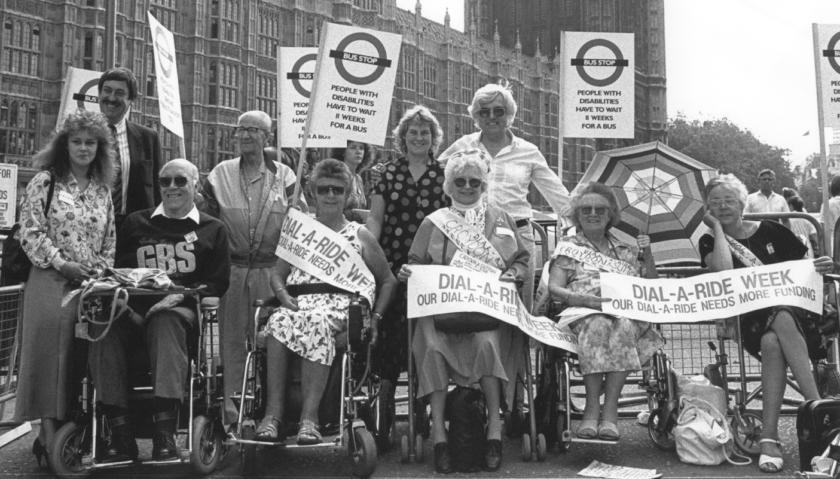
1990s: direct action and protest
...it was quite commonplace for roads in UK cities to be gridlocked by immobilised buses due to disabled people handcuffing themselves to the outer rails or even underneath these inaccessible buses.
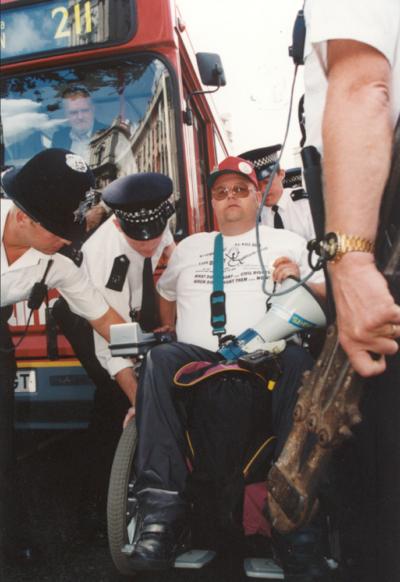
By the 1990s, more and more disabled people were organising and taking action, and several groups started to form to co-ordinate protests and demos. The Campaign for Accessible Transport (CAT) and the Disabled People‘s Direct Action Network (DAN) both used non-violent civil disobedience to draw public and media attention to issues of disability rights. Many LDaRUA members were involved in these groups, and there was plenty of collaboration across the movement.
Right: Police try to remove protester Chris Hughes who had attached himself to a bus during a protest (1994)
We campaigned more vigorously, including giving unofficial help to the Campaign for Accessible Transport who carried out direct action such as chaining their wheelchairs to the entrances of Underground Stations and to the poles on inaccessible buses!
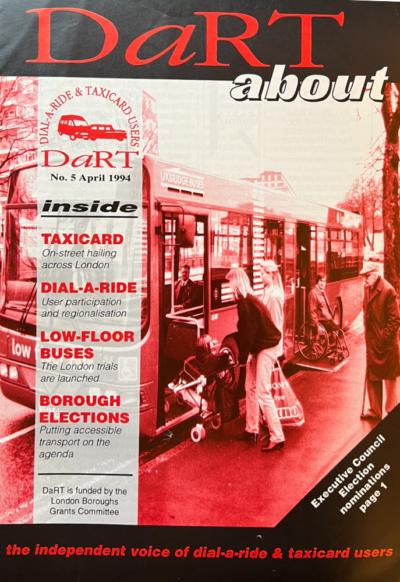
DaRT
In 1992, LDaRUA took over the London Taxicard Users’ association to form Dial-a-Ride and Taxicard Users (DaRT). The merger created an organisation that was dedicated to transforming the capital’s transport network.
While the new name for the organisation, Dial-a-Ride and Taxicard Users Association, sounds fairly specific in scope, a big focus for them from the offset was challenging the lack of accessible public transport.
In the mid-90s, DaRT launched a national campaign for equal access to public transport called All Aboard. One part of the campaign focused on buses, with DaRT commissioning Richard Armitage to organise a campaigning network under the banner Buses for All. A conference was held in Manchester and was chaired by Lorraine Gradwell, who took to the streets afterwards with a group of other wheelchair users to blockade buses outside Manchester Town Hall.
Read more about the All Aboard campaign in Tony Baldwinson’s paper Buses for All: A case study ofa Campaign for access by law to buses by Disabled People in the European Union, 1995 – 2001
Left: DaRT about magazine (1994)
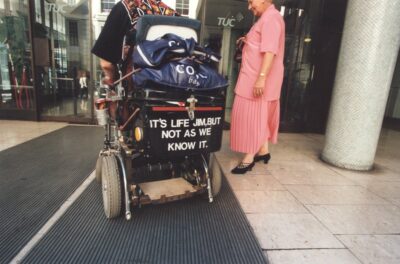
The first accessible buses
Other actions included Early Day Motion in the Commons tabled by Sir John Hannam MP with all-Party support.
By 1995 the first low-floor buses with ramps were being introduced on select routes in London. The subsequent investment into the accessibility of the bus network in the preceding years was testimony to those early campaigns and the tenacity of a generation of accessible transport campaigners.
Right: A member of DaRT arriving at an event ahead of the London Mayoral Elections to hear the candidates speak on accessible transport (1999)
The Government bowed to cross-party pressure over opening up access to public transport in a policy U-turn last night. Minister for Disabled People, William Hague, announced in the report stage debate... new powers covering buses...
2000s: A Mayor for London
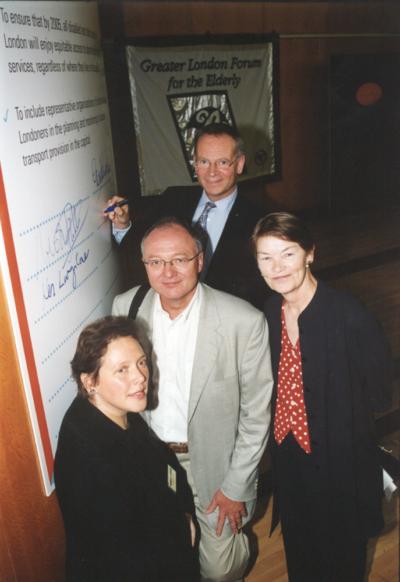
By 2001, DaRT had grown into an organisation with 10,000 members across London, with branches in each of the 32 boroughs. With those numbers, politicians and policy makers knew that the organisation was definitely worth listening to.
Candidates for London Mayor attended meetings to court the members, and many of them signed up to the Accessible Transport Charter in 1999, the Manifesto for London in 2000 and the Nothing About Us Without Us 12 Demands for London in 2004.
But they never forgot their original purpose. Led by the local London borough chapters of DaRT members, a series of protests in central London called for an increase in funding for Dial-a-Ride. Their campaigning tactics grabbed the attention of multiple newspapers, and soon DaRT was called upon to assist with the development of the Mayor’s Transport Strategy. When it was released, thanks to DaRT and all of its members, it included more funding for Dial-a-Ride and an additional £5m a year to improve the Taxicard service.
In 2002, DaRT was given funding by Transport for London to publish a magazine called Transport for All to keep their members and everyone else who was interested in their work a way of keeping up to date about all the developments in accessible transport. This funding was stopped a few years later, but DaRT really liked the name, and decided to use it for something else...
Left: Ken Livingstone and other Mayoral candidates at the launch of the Dial a Ride and Taxicard Users Network Charter (1999)
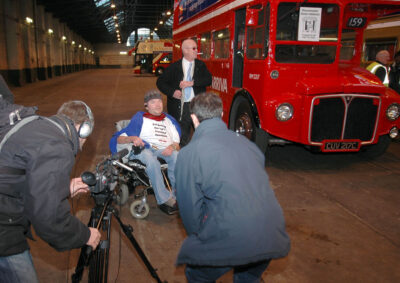
Good Riddance Routemaster
And so our organisation changed name again, this time to Transport for All. There was also a change of focus from just Taxicard and Dial-a-Ride towards all forms of transport, including NHS patient transport, and street space, and of course public transports. While DaRT had been doing all of this for years anyway, the name change made it clear that this was their area of expertise.
The newly formed organisation gained a good amount of attention with campaigns across London like Good Riddance Routemaster , which celebrated the replacement of the iconic and completely inaccessible red London bus, and Staffed Stations are Safe Stations, which campaigned against the closure of ticket offices and reduction of staff on the London Underground.
Right: Dave Morris interviewed by the press at the demonstration to celebrate the old Routemaster buses being taken out of service (2005)
2010s: The hardest hit…
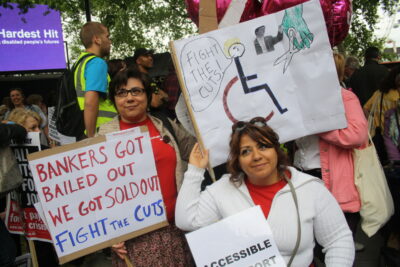
As the climate of austerity cuts bit hard, Transport For All’s message became more important than ever. Across London and the UK, disabled and older people bore the brunt of cuts and changes to the services we used. Transport budgets were not spared and we saw moves to cut the Mobility Component of the DLA for those in residential care, as well as cuts to the much loved and needed Taxicard scheme. In March 2011, we marched with thousands of others in the ‘Hardest Hit’ demonstration through London against the Government’s cuts to benefits and services.
Left: Luisa Ferreira and Iman Saab protesting cuts to disability benefits at the Hardest Hit March (2011)
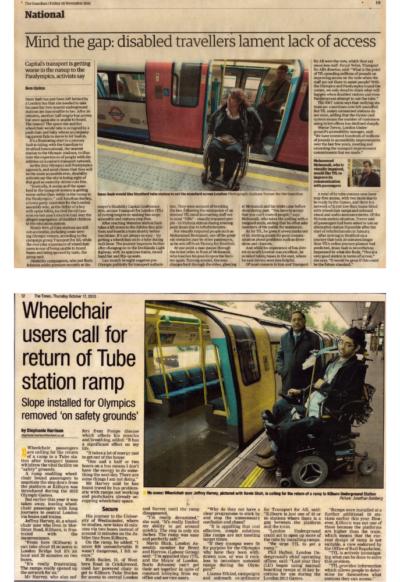
Olympic and Paralympic games
Transport for All really came to public prominence in the run up to the 2012 London Olympics and Paralympics. Ever since London was named as a host city in 2007, Transport for All recognised that the spotlight on London and its transport infrastructure would be a fantastic opportunity to raise the profile of accessibility and make a strong case for improvements and change. Transport for All took up this opportunity and spent much of the time in the run up to and after the games campaigning and lobbying for real Paralympic legacy. Using events and occasions in the public eye became a key form of campaigning, underlining the importance of timing.
As the Games started we launched our ‘Roll Out The Ramps’ campaign. This was about keeping the manual boarding ramps that had been put in place at 16 London Underground stations for the Games. This was the first time ramps of this kind had been used – and we pushed hard for the ramps to stay, and to be rolled out to further stations. Activists all over London invited journalists to see the ramps in action. Some members were able to use their local station for the very first time; another member cut down her twice-daily ninety minute commute by bus to a short journey by train. When the Mayor Boris Johnson attended a People’s Question Time in Stratford, we were there to greet him with tinsel-strewn ‘Roll Out The Ramps’ placards, singing carols about transport access. Just a few days later, TfL announced that the ramps would stay – and that they would be rolled out to a further 19 stations across the network.
Right: Newspaper clippings from The Guardian (2011) and The Times (2013)
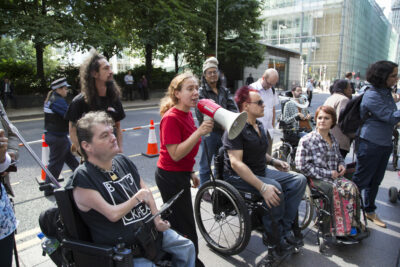
Campaigning for an accessible Crossrail
We faced a new challenge with the plans for Crossrail. Despite being a brand-new railway line built from scratch, and costing a then estimated £15 billion of public money, it initially wasn’t planned to be fully accessible. The original plans included seven stations (Hanwell in Ealing, Manor Park and Maryland in Newham, Seven Kings in Redbridge, and Iver, Langley and Taplow to the West of London) that would remain without lifts and no degree of step-free access.
Transport for All had one simple demand: Crossrail had to be fully accessible to everyone, including older and disabled people, from the moment it opened.
Thinking outside the box of our usual campaigning strategies, we applied pressure straightaway, taking Crossrail to the Advertising Standards Authority (ASA) over adverts which claimed that it was an “accessible railway”, when it very clearly wasn’t. We complained that Crossrail’s promotional posters contravened the advertising code on truthfulness.
Left: Lianna Etkind, Mik Scarlet and Anahita Harding join hundreds of protesters campaigning for an accessible Crossrail (2013)
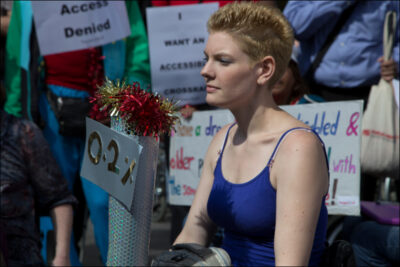
It got their attention, with Crossrail responding to press reports by confirming that “Network Rail and Transport for London are actively looking for additional opportunities to improve accessibility prior to the start of Crossrail services beyond the committed programme.”
Our campaign culminated with our Crossrail day of action in August 2013, which was also the first anniversary of London hosting the Paralympic games. Disabled and older campaigners set out on a Paralympic Legacy Torch Relay along the Crossrail route, highlighting the importance of access and equality.
The big win came in Autumn 2014. The Mayor of London and Transport for London (TfL) first confirmed £19 million funding to install step free access at Seven Kings, Maryland, Manor Park and Hanwell stations. The following month, the Department for Transport announced a further £14 million investment package for Langley, Taplow and Iver stations to be made step-free. This total £33 million additional funding secured access at all seven of the Crossrail stations that had originally been planned without step-free access, a commitment from which tens of thousands of people benefit over the lifetime of the stations.
Right: Our Paralympic Legacy Torch Relay (2013)
2020s: The new normal and beyond
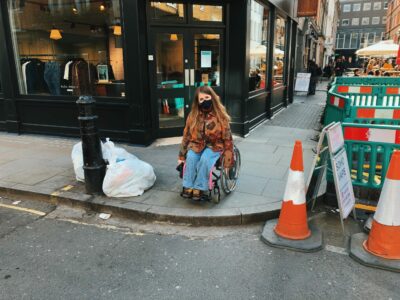
Like so many disabled organisations, Transport For All was hard hit by the COVID-19 pandemic and lockdown. We had to adapt: to the move online furthering digital exclusion and fragmented communities, to the presence of a devastating virus, and to the rapidly changing streetspace in the scramble to the ‘new normal’. Drawing on the tenacity and creativity of the disabled community, we adapted: learning how to arrange British Sign Language interpreters and live captioners for online meetings and webinars, overhauling our organisation’s technology to facilitate remote working while continuing to provide our helpline and casework services, and finding ways to make change when more direct action was unavailable to us. In the first 3 years of this decade we’ve achieved some amazing things, from our ground-breaking research into Low Traffic Neighbourhoods and the barriers to active travel, to securing major improvements to Dial-a-Ride, to successfully opposing plans to close ticket offices at all mainline rail stations in England.
Today, in 2023, we’re 40 years on from the founding of Transport for All, and almost 30 years on from the Disability Discrimination Act. Yet disabled people still experience inequity and discrimination on a vast scale.
This can’t go on. That’s why our ambitious vision is to see transport justice for all disabled people, led by disabled people.
Be a part of our future
We don't want to be here in another 40 years time. Join our movement and help us make sure the future is transport justice for all disabled people.

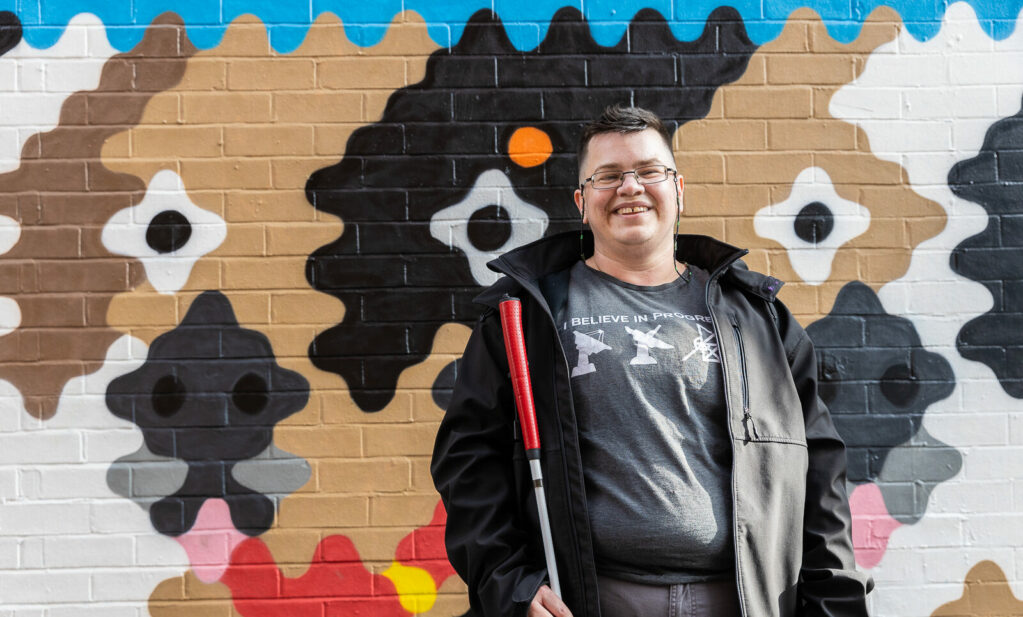
Support us
We can't do this without your support. Take action, give what you can, or sign up as a member - and join our movement of disabled people fighting for a better future.
